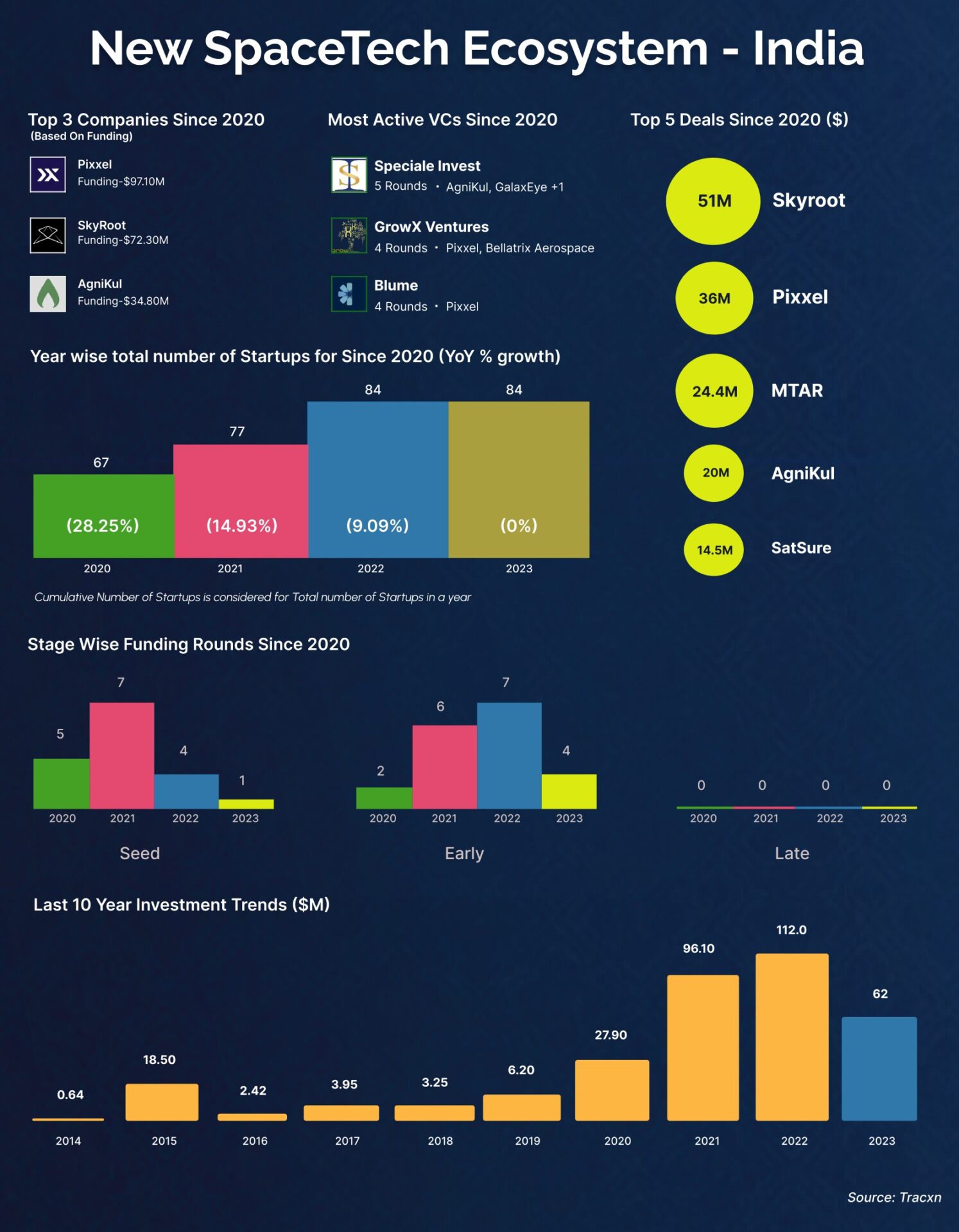After the successful touchdown of Chandrayaan-3’s lander in the south of the Moon, all eyes are on India’s space program. Already, ISRO and the Japan Aerospace Exploration Agency (JAXA) have decided to jointly launch LUPEX, a successor to Chandrayaan-3, in 2026.
In the limelight is also India’s SpaceTech startup ecosystem, which has secured its position as a formidable contender on the global stage. According to recent insights by Tracxn on August 11, 2023, India ranks seventh in terms of funding within the international SpaceTech landscape for the year.

The Indian SpaceTech sector’s journey has been one of transformation, driven by the sector’s privatization in 2020. Previously dominated by governmental players, the sector has witnessed a significant surge in private sector participation post-privatization. Private entities are now actively involved in crucial aspects of research, manufacturing, and fabrication of rockets and satellites, fostering a vibrant ecosystem of innovation.
The funding trajectory of the Indian SpaceTech ecosystem tells a compelling story of growth and resilience. From a modest $35 million funds raised between 2010 and 2019, the sector experienced a meteoric rise in 2020, securing a remarkable $28 million in funding. This trend continued with exponential growth, reaching $96 million in 2021 and an impressive $112 million in 2022, marking a 17% increase from the previous year. This steady expansion in funding sets the Indian SpaceTech sector apart from other industries affected by funding challenges and macroeconomic fluctuations.
Building on its upward trajectory, the Indian SpaceTech sector has already attracted $62 million in funding for the year 2023, reflecting a substantial 60% increase compared to the same period last year. This exceptional growth trend is expected to continue in the upcoming months.
India’s emergence as a potent player in SpaceTech is further highlighted by its impressive satellite deployment. With 381 satellites placed in low orbit, India has positioned itself as a key player in this arena. Notably, the successful launch of 36 satellites into orbit by ISRO for UK-based OneWeb illustrates India’s contribution to global satellite ownership.
The funding trajectory of the Indian SpaceTech ecosystem tells a compelling story of growth and resilience
The Indian private sector has taken the lead in launching satellites for practical applications, including satellite-based communication services like phone signals, broadband, OTT, and 5G. The government’s Budget 2023 initiatives further support the private enterprises’ role in this sector, from launching satellites and rockets to operating Earth stations with a 0% GST regime. Plans for a Production Linked Incentive (PLI) scheme for satellite manufacturing are also in the pipeline.
India’s space agency, ISRO, boasts a series of remarkable milestones, including the successful landing of Chandrayaan-3 on the moon’s south pole, paving the way for groundbreaking studies in the region. Also, India achieved a major achievement by becoming the first country to successfully land a spacecraft near the moon’s south pole. Additionally, ISRO’s feat of deploying a record-breaking 104 satellites in sun-synchronous orbits during a single mission in 2017 stands as a testament to India’s prowess.
Among the thriving business models within the Indian SpaceTech sector, Small Payload-based Launch Vehicles have garnered significant attention, securing $75.6 million in funding over the last two years. Key players such as Skyroot, AgniKul, and Pixxel are spearheading innovative endeavours that promise to reshape the industry landscape. Skyroot, for instance, has launched India’s first privately built rocket, Vikram-S, into space, with plans to revolutionize satellite launches.
Satellite-based Imaging Solutions have also witnessed substantial support, with $84.2 million in funding secured over the past two years. Companies like Pixxel have introduced pioneering technologies for earth observation, while Dhruva Space and Bellatrix Aerospace are contributing to the sector through their unique offerings.
The global space industry is undergoing a phase of rapid innovation, spanning 3D-printed rocket components, commercial space tourism, reusable launch vehicles, asteroid mining, and novel propulsion technologies. In this ever-evolving landscape, India stands poised to capitalize on emerging opportunities, underlined by its proven capabilities in manufacturing and satellite/launch vehicle development.
The accomplishments of the Indian Space industry, bolstered by government support, are expected to fuel entrepreneurship and investments, ushering in a new era of innovation and growth in the years ahead.












